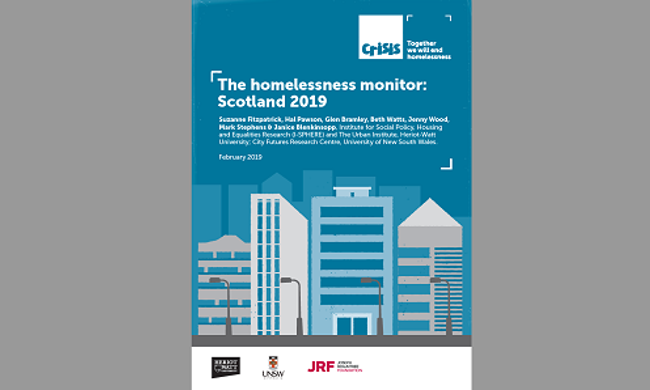The Homelessness Monitor: Scotland 2021
29.09.2021
The Homelessness Monitor: Scotland 2021 is the latest edition of a longitudinal study into the homelessness impacts of recent economic and policy developments in Scotland. This year’s Scotland Monitor is an account of how homelessness stands in Scotland in 2021, or as close to 2021 as data availability allows. It also highlights emerging trends and forecasts some of the likely future changes, identifying the developments likely to have the most significant impacts on homelessness.
Key findings
- Statutory homelessness had been on a steadily rising trajectory pre pandemic, with the number of households assessed as legally homeless having grown by 10% in the period 2016/17-2019/20. The pandemic year 2020/21 saw a year-on-year fall in statutory homeless acceptances of 13% (to 27,571), and 20% in the first quarter of 2020/21 (April-June) compared to the previous quarter.
- The number of households in temporary accommodation had been at a stable high of 10-11,000 for the decade up until March 2019. In March 2021, the numbers in temporary accommodation stood at over 13,000, well above the previous peak of 11,665 a year previously.
- ‘Core homelessness’ – a concept which captures the most severe and immediate forms of homelessness – is estimated to have stood at 14,250 households on a given night in Scotland in 2019, having been relatively stable over the preceding seven years. Rates of core homelessness are substantially lower in Scotland (0.57% of households) than in England (0.94%) and Wales (0.66%).
- Homelessness has been a renewed policy priority in Scotland for the five years or so preceding the COVID-19 pandemic. In 2018, the Scottish Government published the Ending Homelessness Together Action Plan, taking forward all recommendations of the Homelessness and Rough Sleeping Action Group (2017/18).
- Local authority Rapid Rehousing Transition Plans are a key delivery mechanism for the Action Plan. Around half of local authorities have already made changes to social housing allocations policies as a result of these Plans, primarily increasing priority to homeless households. While the COVID-19 pandemic interrupted implementation, the Plans were seen to have supported responses to the crisis. Despite increases in the Scottish Government funding committed to implementation, there are concerns that the Plans remain acutely under-resourced.
- The Scottish Government’s response to the COVID-19 pandemic focused on accommodating people sleeping rough and decanting night shelter accommodation using hotel or other single-room accommodation. These measures were credited by key informants and some local authorities with reducing rough sleeping to unprecedently low levels. Statutory data indicate a year on year national-level reduction in the region of 10 to 16%, but key informant views suggest reductions of greater magnitude. In combination with enhanced safety measures in congregate accommodation, the homelessness response to COVID-19 was also seen to have kept COVID-19 infection rates to a minimum among homeless and at-risk populations.
- A range of short-term measures are modelled as being able to alleviate a post-pandemic rise – and in fact reduce – core homelessness, with the biggest potential associated with the use of rapid rehousing to settled accommodation. Specifically, in relation to rough sleeping, the most impactful practices would be prioritised access to settled housing and continued use of the special COVID-related provision of hotel type accommodation.
- In the longer term, large projected core homelessness reductions could be generated by rapid rehousing quotas, prevention and welfare measures, raising the Local Housing Allowance, and sustained expansion of Housing First and accompanying reduction in traditional hostel accommodation. Social housing supply increases, even when carefully targeted at the most under pressure areas, have limited beneficial effects that materialise only in the longer term, though such changes may enable others measures, particularly rapid rehousing.
Click on the PDFs below to read the executive summary or the full report.
To read the technical report accompanying the 2021 Homelessness Monitors for Scotland and Wales, please visit this link:
https://pure.hw.ac.uk/ws/portalfiles/portal/51616567/CoreHomelessnessProjections2021_TechReport_ScWa2_002_.pdf



